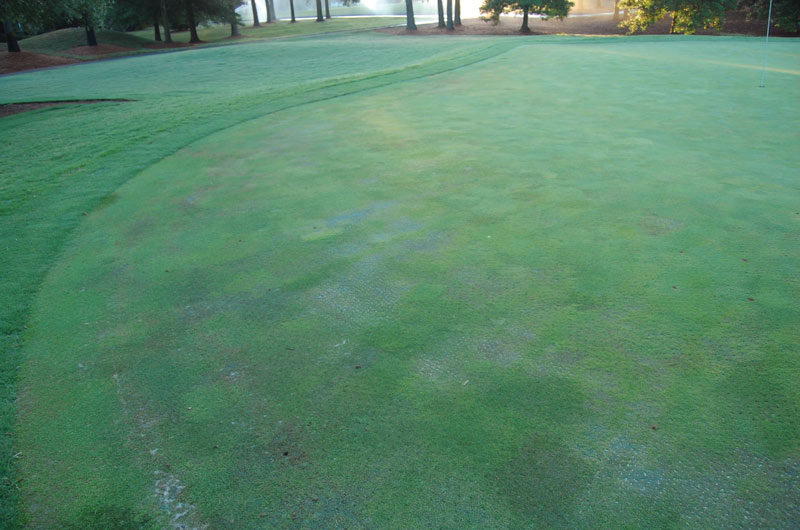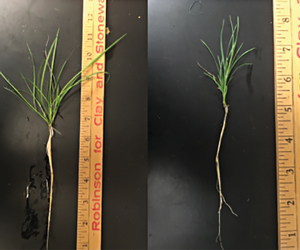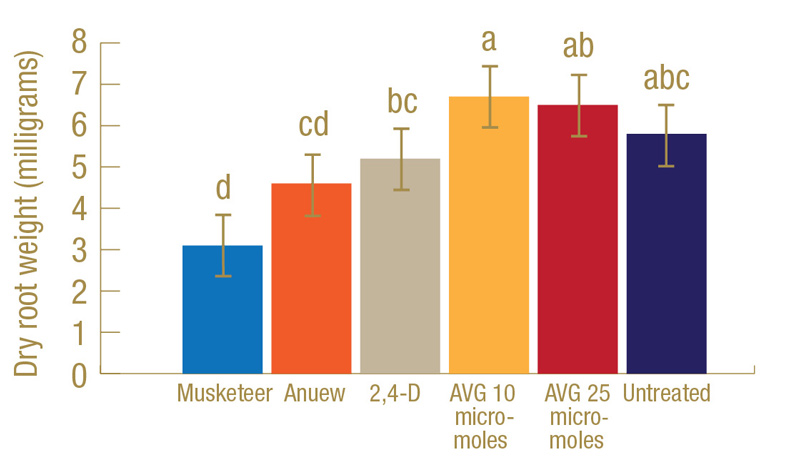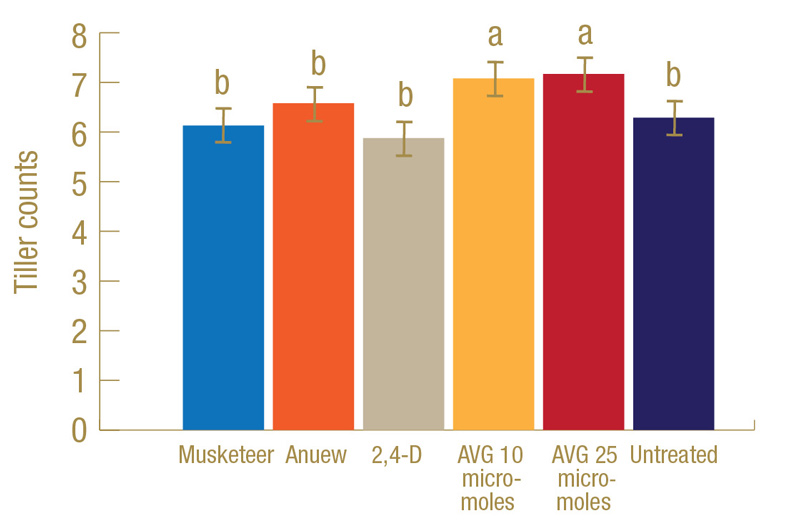
Figure 1. In field settings, plants may be subjected to more than one stress simultaneously, and there is evidence that plant response to multiple stresses may be unique or shared. Photos by Arly Drake
Editor’s note: This research was funded in part by GCSAA through a grant from the Environmental Institute for Golf.
Creeping bentgrass (Agrostis stolonifera) is a turfgrass species that is widely used on golf courses throughout the United States. In field settings, plants may be subjected to more than one stress simultaneously, and there is evidence that plant response to multiple stresses may be unique or shared (8) (Figure 1, above).
Numerous studies have investigated the effects of combined heat and drought stress on plant growth, but few have investigated the effects of combined heat and salt stress (8). Additionally, plant hormones are involved in plant stress response, and plant growth regulators (PGRs) are commonly applied on golf course turfgrass to alter growth and improve health.
For these reasons, experiments were designed to observe how creeping bentgrass would respond to heat stress, salt stress, and heat and salt stress combined, and how various PGRs would affect plant health during stress. The aims were to determine how combined heat and salt stress affected creeping bentgrass, and whether any PGR products could improve plant health and growth during stress. Although plant hormone levels were not measured, it was hoped the experiment could provide clues to guide further research in that area.
Research trials and results
To determine the effects of the stresses, Penncross creeping bentgrass was germinated in a greenhouse mist room, and at 12 days post-germination, seedlings with similar growth and development were transferred to hydroponics systems located in two different growth chambers. The hydroponics systems were filled with one-quarter-strength Hoagland’s hydroponics solution (2). At 16 days post-germination, the solution was replaced with fresh solution, and heat- and salt-stress treatments were initiated.
Heat- and salt-stress treatments
The salt-stress treatment consisted of one-quarter-strength Hoagland’s solution (a standard nutrient solution for plants) that had sodium chloride added. The sodium chloride concentration used was based on previous turfgrass salt-tolerance research (1, 10). The no-salt treatment was a one-quarter-strength Hoagland’s solution alone. The heat treatment was 95/86 F (35/30 C) day/night temperatures, and the non-heat treatment was 77/68 F (25/20 C) day/night temperatures. The temperature regimes were selected based on known ideal temperatures for growth and previous research (5, 12). The stresses were applied for 14 days, and the hydroponics solution (with and without salt) was replaced every third day.

Right: Figure 2. Creeping bentgrass grown without stress treatments (left) and with both heat- and salt-stress treatments (right) 30 days post-germination.
At 30 days post-germination, the plants were harvested, and root and shoot weights, tiller count, electrolyte conductivity (an indirect measure of plant cell membrane integrity), and total chlorophyll content were measured. This experiment was repeated four times. Experiment results indicated that the heat-stress, salt-stress and combined-heat-and-salt-stress treatments were sufficient to reduce creeping bentgrass growth and health (Figure 2).
PGR treatments
After it had been established that the stress treatments were effective, a second experiment was carried out in the same manner as outlined above, with PGR applications made at 15 days post-germination. That experiment was repeated six times.
The first treatment used the PGR combination product Musketeer (SePro). This product contains flurprimidol, paclobutrazol and trinexapac-ethyl, all of which are gibberellin synthesis inhibitors. It was applied at the label-recommended rate of 24 fluid ounces/acre (1.7 liters/hectare) using a hand-held CO2-powered spray boom calibrated to spray 2 gallons/1,000 square feet (814.9 liters/hectare).
Treatment 2 was the gibberellin synthesis inhibitor product Anuew (Nufarm), which contains the active ingredient prohexadione calcium. It was applied at a label-recommended rate of 9 ounces/acre (0.255 kilogram/0.4 hectare) using the same spray boom.
Treatment 3 was the synthetic auxin 2,4-dichlorophenoxyacetic acid (2,4-D) applied at a rate of 1.5 fluid ounces/1,000 square feet (4.7 liters/hectare). This rate was derived from typical rates of 2,4-D used safely on creeping bentgrass when applied as a selective herbicide.
Treatment 4 was a 10-micromolar solution of AVG (aminoethoxyvinylglycine, an ethylene synthesis inhibitor), and treatment 5 was a 25-micromolar solution of AVG. Using a small hand-held spray bottle, these treatments were applied at a rate of 0.2 ounce (6.25 milliliters) solution/plant. The solutions and rates of application were based on those used in previous research (12).
Treatment 6 did not receive a PGR treatment, but was sprayed with water at a rate of 2 gallons/1,000 square feet (814.9 liters/hectare) using the spray boom.
Results from the second experiment
Results from the second experiment showed that AVG-treated plants generally performed better than plants receiving all the other treatments during heat and salt stress. As can be seen in Figures 3 through 5 (below), plants treated with AVG had higher biomasses and more tillers when compared with other plants receiving PGR treatments across all stress levels. An interaction was detected between the stress and PGR treatments. As stress was added, electrolyte leakage increased, and AVG-treated plants displayed lower levels of leakage in the presence of stress compared with other PGR treatments (not shown).

Figure 3. Dry shoot weight means as affected by PGR treatment. Error bars represent least significant difference.

Figure 4. Dry root weight means as affected by PGR treatment. Error bars represent least significant difference.

Figure 5. Tiller count means as affected by PGR treatment. Error bars represent least significant difference.
Many different plant stresses can cause many different plant species to increase ethylene production (7). Ethylene is considered a stress-response hormone, as its presence is generally required for plant stress response (11). Different stresses have varying effects on intensity of ethylene production and how suddenly the plants become stressed, and excess ethylene production can reduce plant growth and increase senescence (11).
AVG. It appears the rates of AVG used in this experiment likely prevented some excess ethylene production in creeping bentgrass under stress conditions, but that ethylene biosynthesis was not completely impaired. These findings were similar to those of earlier research (6). AVG has also been cited as alleviating heat stress by reducing ethylene production (4), and our results are consistent with that research as well.
2,4-D. Although 2,4-D is typically safe on creeping bentgrass at the rate we used, a typical recommendation is to avoid using products that contain 2,4-D when the turfgrass is heat-stressed (9). In this experiment, it is likely that 2,4-D was slightly harmful. Although no injury was visible, there was slight growth, total chlorophyll content reduction and increased electrolyte leakage compared with the untreated plants.
Gibberellin synthesis inhibitors. Gibberellin synthesis inhibitors are meant to be applied to healthy, actively growing turfgrass. The timing of the application used in this experiment was likely inappropriate, as transplanting was stressful (as evidenced by high mortality). It typically takes sequential applications to generate plant health benefits, and in this experiment, applications were made just 24 hours before stress initiation (3). The results indicate that suppressing growth with gibberellin synthesis inhibitors without generating any health benefits from the prolonged use of such PGRs had a negative effect on creeping bentgrass during stress. For plants treated with gibberellin synthesis inhibitors and not subjected to stress, growth was reduced (as is the point of using such products), but electrolyte leakage and total chlorophyll content were similar to those of plants in all the other treatments, an indication that the plants were healthy.
Unfortunately, because of the timing of the gibberellin synthesis inhibitors, this experiment may not have done much to help elucidate the role of gibberellins during heat stress, salt stress, and heat and salt stress combined. In order to examine the potential use of these products during plant heat and salt stress, it may be best to have sequential gibberellin synthesis inhibitor applications made before stress initiation. It would also be reasonable to apply the various gibberellin synthesis inhibitors individually and in combinations of late- and early-stage-inhibition active ingredients.
A positive result of this experiment is that AVG could potentially be used as a turfgrass PGR to improve growth and health during periods of heat stress, salt stress, and heat and salt stress combined. Although AVG could be expensive, it is effective at low rates and has potential as an emergency application because it was applied only one day before stress initiation.
Future lines of inquiry into the use of AVG on creeping bentgrass arising from this research include the use of lower rates and determining how long AVG is effective. This research did not separate osmotic and ionic stress, and it would be useful to know whether AVG alleviates both ionic and osmotic stress, or just one of them. In conclusion, AVG helped maintain creeping bentgrass growth during heat and salt stress and may have potential as a commercial turfgrass health product.
Funding
This work was funded by the Environmental Institute for Golf, Central Ohio GCSA, Miami Valley GCSA and Northern Ohio GCSA.
Acknowledgments
The information presented in this article was originally published in a dissertation as part of a doctorate program at Ohio State University (Columbus, Ohio) under David Gardner, Ph.D. (https://etd.ohiolink.edu/pg_10?0::NO:10:P10_ACCESSION_NUM:osu1546450732510932)
The research says ...
- We tested the effects of heat stress, salt stress and the two stresses combined on Penncross creeping bentgrass; all treatments reduced plant growth and health.
- The stress experiments were repeated with five PGR treatments (Musketeer; Anuew; 2,4-D; two different solutions of AVG) and a control (water).
- Plants treated with AVG performed better than plants in the other treatments and showed lower levels of electrolyte leakage.
- The timing of application of the gibberellin synthesis inhibitors was inappropriate, and further research is needed to determine their effectiveness in reducing stress and increasing plant health.
Literature cited
- Alshammary, S., Y. Qian and S. Wallner. 2004. Growth response of four turfgrass species to salinity. Agricultural Water Management 66(2):97-111.
- Arnon, D.I. 1949. Copper enzymes in isolated chloroplasts. Polyphenoloxidase in Beta vulgaris. Plant Physiology 24:1-15.
- Ervin, E., and X. Zhang. 2007. Influence of sequential trinexapac-ethyl applications on cytokinin content in creeping bentgrass, Kentucky bluegrass and hybrid bermudagrass. Crop Science 47:2145-2151.
- Kahn, M.I.R., M. Asgher and N.A. Kahn. 2014. Alleviation of salt-induced photosynthesis and growth inhibition by salicylic acid involves glycinebetaine and ethylene in mungbean (Vigna radiata L.). Plant Physiology and Biochemistry 80:67-74.
- Larkindale, J., and B. Huang. 2004. Thermotolerance and antioxidant systems in Agrostis stolonifera: involvement of salicylic acid, abscisic acid, calcium, hydrogen peroxide and ethylene. Plant Physiology 161(4):405-413.
- Liu, X., and B. Huang. 2000. Heat stress injury in relation to membrane lipid peroxidation in creeping bentgrass. Crop Science 40(2):503-510.
- Morgan, P.W., and M.C. Drew. 1997. Ethylene and plant response to stress. Physiologia Plantarum 100:620-630.
- Pandey, P., V. Ramegowda and M. Senthil-Kumar. 2015. Shared and unique responses of plants to multiple individual stresses and stress combinations: physiological and molecular mechanisms. Frontiers in Plant Science 6: Article 723.
- Patton, A.J., and D.V. Weisenberger. 2016. Turfgrass Weed Control for Professionals. 5th revision. Purdue University Extension Publication. AY-336. West Lafayette, Ind.
- Qian, Y.L., S.J. Wilhelm and K.B. Marcum. 2001. Comparative responses of two Kentucky bluegrass cultivars to salinity stress. Crop Science 41(6):1895-1900.
- Tao, J.-J., H.-W. Chen, B. Ma, W.-K. Zhang, S.-Y. Chen and J.-S. Zhang. 2015. The role of ethylene in plants under salinity stress. Frontiers in Plant Science 6: Article 1059.
- Xu, Y., and B. Huang. 2009. Effects of foliar-applied ethylene inhibitor and synthetic cytokinin on creeping bentgrass to enhance heat tolerance. Crop Science 49(5):1876-1884.
Arly Drake is an assistant professor at Clark State Community College in Springfield, Ohio, teaching agriculture and horticulture. T. Karl Danneberger and David Gardner are professors in the Department of Horticulture and Crop Science at Ohio State University, Columbus, Ohio.